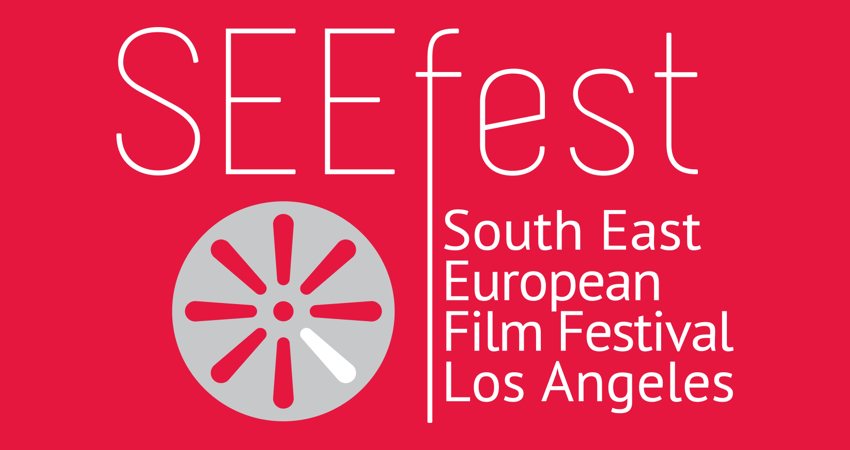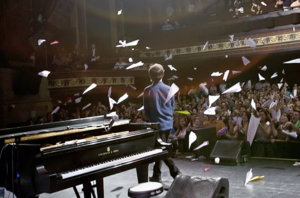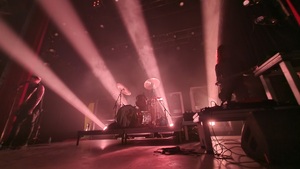
From Montenegro to Moldova: The Best of SEEFest 2017
Los Angeles, CA • April 27 – May 4, 2017
by Generoso and Lily Fierro
Shortly after arriving in Los Angeles in 2015, we had the good fortune to attend a Croatian film festival at the historic Egyptian Theater in Hollywood. We caught a couple of fine films from the modest festival that took place over a weekend in two theaters, which still went far in impressing us, for we were unaware of the quality of film that was coming out of Croatia at the time. It was immediately impressed on us that we were living in a city, with its varied populations and its standing as a center of the film industry, that could support these smaller festivals from countries not particularly known in international film circles. It is often the case that you might find yourself knee-deep in some country’s film festival without even knowing it – such was the case a few weeks ago when we attended a screening of Bruce McDonald’s new film, Weirdos, at the Aero Theater in Santa Monica. Upon arriving, we realized that we were in the middle of the Canada Now series, which presented new cinema from the Great White North.
From these experiences, we’ve learned to keep watch for upcoming series and festivals, and we have realized that it takes a serious amount of scheduling ability to wade through the myriad of festival options from not only individual countries but also of geographical groupings that include many nations that could potentially host a festival of immense programming quality on their own. Romania immediately comes to mind as a nation that consistently produces an abundance of strong films. It alone could helm a festival of its own cinema, as could Greece (which does have its own festival in town), but films from both of these established countries as well as ones from burgeoning film producers such as Moldova, Georgia, and Montenegro were part of the focused programming of SEEFest, the South East European Film Festival, which took place from April 27th to May 4th.
Unlike many film festivals, what distinguished SEEFest to us was their commitment to screening films that one could never in a million years describe simply (and dismissively) as “crowd-pleasers.” The predominance of the work that we saw was comprised of emotionally intense films that addressed the political and cultural impact of each country’s particular history. And with the understanding of the political climates and the film industries of the countries in South East Europe, SEEFest also included their ninth annual Business of Film Conference and their Accelerator Program, where many of the visiting filmmakers had a chance to pitch their upcoming projects to a jury of industry professionals, conveying their commitment to supporting film production in the regions represented by their programming and giving their festival another life that will live far beyond the week of film screenings. These efforts in this day and age are greatly needed so that we can continue to see the same high level of output from these regions in the years to come. Given these supportive initiatives and the high quality of programming that we saw at this year’s SEEFest, we will mark our calendars with great anticipation for the festival next year.
“Vera A”
As reviewers, SEEFest has also given us an ability that we have never had when reviewing festivals in the past. One of the things that always breaks our heart about our coverage of premier festivals like AFI Fest is that many of the films will not be screened in theaters for several months after you read our review. Thankfully, four of the titles that we have selected as our favorites of the features are available for you to view at home on Films2C.com until June 3rd.
Over the week-long SEEFest, we saw a total of fourteen feature films, which included narratives and documentaries, and an even larger number of shorts. For the purposes of this piece, we will provide our short reviews for the features we hope that you do not miss. Of the features that we highlight below, an astonishing total of five out of the seven are debut features.
An impressive debut feature from the Turkish-born but Italian-educated Kivanç Sezer about his country’s worker safety issues that have been worsened by earthquakes in Turkey and subsequent shortages of properly built homes, My Father’s Wings uses as its narrative engine the story of master builder İbrahim (Menderes Samancilar), who labors at a construction site where payments have become nebulous and is in dire need of funds to support his family. İbrahim works at the site with his nephew Yusuf (Musab Ekici), a brash young man who is eager to climb the ladder of success and become his own boss. A pensive drama that is framed in the Italian neorealist tradition, My Father’s Wings provides the viewer with a glimpse into the growing crisis of housing demand leading to an exploitative situation for low wage builders who are trying to maintain a balance between survival and dignity. The flawless performances by Samancilar and Ekici create complementary perspectives on life for two different generations, and combined they form characters that express our own concerns and sometimes naïve optimism in our changing society. This is the first part of a projected trilogy that Sezer hopes to make that centers around the building of this property in the suburbs of Istanbul. We sat down with the director for an interview that you can read here.here.
“Kivanc A”
It is hard not to think of the 2001 Ken Loach film, The Navigators, the story of the privatization of lines on the British Rail and the dire consequences that resulted from it, while watching Kristina Grozeva and Peter Valchanov’s film, Glory. Railway worker Tzanko Petrov (Stefan Denolyubov) discovers a large amount of money while working on the tracks, and much to the jeers of his coworkers, gives the money back to the national rail, who decides to reward him by stealing the watch his father gave him and replacing it with one that does not keep accurate time. Complete with a stutter, a beard, and the appropriate amount of outrage, Tzanko is the biblical Moses to the modern Aaron, who takes the form of evil PR executive Julia Staykova (Margita Gosheva), and the media outlets she controls. Though this may sound heavy-handed, Glory wins due to its sympathetic central figure who subsists on a meager salary and the desire to simply do a good job in the face of overwhelming corruption around him. Grozeva and Valchanov not only create a righteous and unpredictable protagonist, but also a complex villain who subverts the system for her own profession’s interests while simultaneously destroying her personal goals. Glory not only comments sharply on the manipulation of perfection for the attainment of a superficial, public persona, but also embeds a thorough discourse on the demasculinization of men and the masculinization of women in modern Bulgaria. In its simplest form, Glory, like Loach’s The Navigators, tells a precautionary tale about the dangers of further disrupting a system that is clearly not perfect but has proven to be functional.
“Glory A”
There is something perversely irresistible about watching the maniacal behavior of a fractured member of the clergy. There is much to be learned from someone who has clearly studied a text that should give him an ample amount of societal codes of conduct, yet disregards them the same way a layperson would when faced with a community that is as equally broken as the clergyman in question. Such is the case with The Black Pin’s protagonist, Petar (Nikola Ristanovski), a foul-mouthed, surly orthodox priest who barely keeps his parish afloat in the scenically idyllic Montenegrin village so that he can stay in his home to take care of his son and his ailing mother who is suffering from Alzheimer’s. Things are already hanging by a thread when some of his boorish parishioners mount together to convince our misanthropic priest to package his land along with theirs for sale to nefarious English investors who want to turn their lands into luxury resorts. What transpires in this darkly comic and entertaining debut by Ivan Marinović is more than your average “little town and its wacky people” type of film; The Black Pin illustrates the precarious nature of being a spiritual leader who is at odds with who he wants to be against the balance of distancing himself from the people in the community that he is ordained to serve. We enjoyed this film a great deal, and it would have placed higher on our list had the ending resolutions not come together as neatly as they do.
“Black Pin A”
Set in August of 1968, That Trip We Took With Dad, is the debut feature by Romanian director Anca Miruna Lǎzǎrescu, who conveys her own family’s story of a trip to Germany that was interrupted by the Soviet invasion of Czechoslovakia. Mihai (Alexandru Margineanu) is a small town doctor in Romania who finagles a trip to West Germany to get a much needed surgery for his father who is suffering from a debilitating brain condition. In tow is Mihai’s brother Emil (Razvan Enciu), a guitar playing rabble-rouser who pines for his girlfriend and an existence in an autonomous Romania. The film is an ambitious debut feature for Lǎzǎrescu, as she succeeds in constructing a narrative based on a heartfelt and personal story while keeping the continuity together with the well-documented historical moments that occurred during her family’s journey.
That Trip We Took With Dad does well in creating sympathetic main characters within a story that is compelling on its own, and the overall scale of the film for a debut feature is formidable, but where Lǎzǎrescu’s film somewhat falters is in the construction of the character of Ulli, the woman who becomes the love interest for Mihai in West Germany and the potential catalyst for Mihai’s decision to avoid returning to Romania. Ulli, as a character, was not fleshed out enough to make her a major factor in Mihai’s decision-making process in the final third of the film, which causes a loss of much-needed tension, but ultimately That Trip We Took With Dad culminates in a very real conclusion that is true to the central characters of Mihai and Emil. We were lucky to speak with Anca Miruna Lǎzǎrescu about her film, which you can read here.
“Anca A”
One of the more striking naturalist films that we have seen in some time arrived in the form of the Moldovan/German produced feature, Anişhoara. Director Ana-Felicia Scutelnicu painstakingly constructs a portrait of the titular teenaged villager who is played with silent intensity by Anişhoara Morari. The narrative structure of the film is first told through a folktale that is recited directly into the camera and is then broken down into four segments via the seasons of the year. Anişhoara is seen going through the tedium of her day to day life, gathering food, slathering guano on the side of her family’s decaying house, and taking care of her younger brother and severely alcoholic father. During the different seasons in the fields, mountains, and sea near her home, we see our mostly silent protagonist meet male suitors who present her with a potential escape plan for her dreary life, and it is here that director Scutelnicu excels by allowing Morari to respond to many of these moments with a subdued reaction that feels realistic given her character’s domestic situation, while also still keeping the audience invested in Anişhoara as we await the moment that might finally push our heroine to make a decision that may finally change her life for the better. Though we greatly admire most of the choices in the development of Anişhoara, the pace of the film could have benefitted with an increase in tempo as some scenes do feel overly observational without effect. In the end, Anişhoara is an engrossing character study in the naturalist style that is to be admired for the restraint and brutal honesty that so many of the films within that genre execute so well, but it is notable that director’s Scutelnicu’s film cleverly uses the framework of fairytale structure against the naturalist genre to bypass the inevitable and now somewhat predictable moment when the world around the central figure of the piece inevitably must come crashing down around them.
“Anisoara A”
We have to begin this review of My Aunt In Sarajevo with an extra nod of appreciation to the programmers of SEEFest who thoughtfully placed director Goran Kapetanović’s short film, Refugee 532, a prequel of sorts, before the presentation of his debut feature. Refugee 532, based on the director’s own experience escaping from war-torn Bosnia to a settlement camp in Sweden when he was a boy, effectively establishes the context for Zlatan (Milan Dragišic), the main character of My Aunt In Sarajevo. Zlatan’s daughter Anja (Julia Ragnarsson) has lived her entire life in Sweden, but longs to see Sarajevo, the birthplace of her father. Though Zlatan has been financially supporting his aunt who has never left their hometown, he has no desire to see her or to go back to the city that he fled during the conflict in 1992. Despite his protest, Zlatan acquiesces and takes his daughter to meet her great aunt in Sarajevo, the place where he suffered the most tragic moments of his life.
Given the dour nature of this premise, it is surprising that what ensues over the next two-thirds of the film is a sometimes bizarre mix of humor, absurdity, and pain, all of which occurs in a running time of fifty-eight minutes. Though the film emotionally struck us, one of the casualties of the short running time was the limitation in character development; My Aunt In Sarajevo accomplishes plenty in its exploration of sorrow and reconciliation of one’s past in less than an hour, but in order to so, the characters lack a certain naturalness, and their actions and dialog occasionally feel like a means to an end, albeit a captivating end aided by a powerful performance from actor Milan Dragišic.
“Milan Dragisic A”
In the same tradition of the Dardenne brothers’ Rosetta comes Anna’s Life, the intensely intimate portrait of a single mother from Tbilisi who works a multitude of jobs and does whatever else she can to make a living for her and her severely autistic child while simultaneously plotting her exit from her country and her oppressive existence. In the same way Émilie Dequenne carries the aforementioned Rosetta, Ekaterine Demetradze carries Anna’s Life; the young actress delivers a raw and visceral performance, which at many times makes believable even the sometimes unbelievable nature of her character’s motivations. Nino Basilia’s direction is on point in her feature debut, keeping the pace of the film aligned with the desperate performance delivered by Demetradze that holds the tension of her film strong throughout so that the overall message gets through clearly: Anna is just another lost part of a place where everyone barely subsists due to a broken governmental and social system that is designed for them to fail.
“Anna’s Life A”
Special thanks goes out to festival founder Vera Mijojlić and to the Director of Feature Programming, Chantal Chauzy, as well as the many volunteers of SEEFest who made this one of the most satisfying festival experiences of the year.
Available for on demand watching via Films2C.com until June 3rd, are four of the features that we reviewed above as well as many of the excellent short films that screened at SEEFest 2017: SEEFEST on FILMS2C ◼
“Closing Night Ceremony A”












